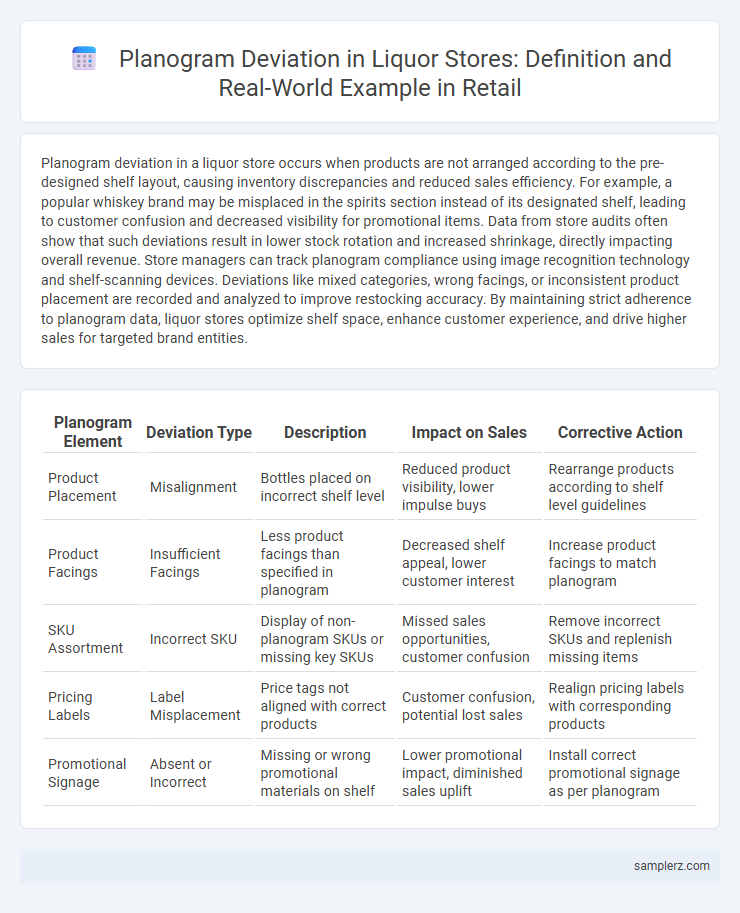Planogram deviation in a liquor store occurs when products are not arranged according to the pre-designed shelf layout, causing inventory discrepancies and reduced sales efficiency. For example, a popular whiskey brand may be misplaced in the spirits section instead of its designated shelf, leading to customer confusion and decreased visibility for promotional items. Data from store audits often show that such deviations result in lower stock rotation and increased shrinkage, directly impacting overall revenue. Store managers can track planogram compliance using image recognition technology and shelf-scanning devices. Deviations like mixed categories, wrong facings, or inconsistent product placement are recorded and analyzed to improve restocking accuracy. By maintaining strict adherence to planogram data, liquor stores optimize shelf space, enhance customer experience, and drive higher sales for targeted brand entities.
Table of Comparison
| Planogram Element | Deviation Type | Description | Impact on Sales | Corrective Action |
|---|---|---|---|---|
| Product Placement | Misalignment | Bottles placed on incorrect shelf level | Reduced product visibility, lower impulse buys | Rearrange products according to shelf level guidelines |
| Product Facings | Insufficient Facings | Less product facings than specified in planogram | Decreased shelf appeal, lower customer interest | Increase product facings to match planogram |
| SKU Assortment | Incorrect SKU | Display of non-planogram SKUs or missing key SKUs | Missed sales opportunities, customer confusion | Remove incorrect SKUs and replenish missing items |
| Pricing Labels | Label Misplacement | Price tags not aligned with correct products | Customer confusion, potential lost sales | Realign pricing labels with corresponding products |
| Promotional Signage | Absent or Incorrect | Missing or wrong promotional materials on shelf | Lower promotional impact, diminished sales uplift | Install correct promotional signage as per planogram |
Common Planogram Deviations in Liquor Store Shelving
Common planogram deviations in liquor store shelving include inconsistent product facings, where popular brands receive fewer facings than prescribed, affecting visibility and sales. Misplacement of premium spirits on lower or less visible shelves reduces impulse purchases and overall revenue. Overstocking certain categories like whiskey while understocking others such as vodka disrupts inventory balance, leading to lost sales opportunities and customer dissatisfaction.
Examples of Out-of-Stock Issues in Liquor Displays
Planogram deviations in liquor stores often result in out-of-stock issues such as empty shelves in high-demand sections like whiskey or vodka displays, disrupting customer purchasing patterns. Misplaced products, like seasonal wines located away from their promotional zones, cause inventory imbalances and delay restocking efforts. Frequent occurrences include missing popular craft beers in prominently featured coolers, leading to lost sales and diminished shopper satisfaction.
Misplaced Bottles: When Brands Break the Planogram
Misplaced bottles in liquor stores disrupt the planned visual hierarchy, causing brands to break the established planogram and confuse customers. This deviation leads to reduced shelf efficiency, lower sales of premium spirits, and increased difficulties in inventory management. Retailers must enforce strict compliance to planogram guidelines to maintain brand integrity and optimize product placement for maximum consumer engagement.
Facing Errors: Wrong Bottle Orientations in Liquor Sections
Facing errors in liquor store planograms frequently occur when bottles are placed with incorrect orientations, such as labels facing sideways or backward, disrupting customer visibility and brand recognition. Misaligned bottle facings can lead to decreased sales for premium spirits due to reduced shelf appeal and difficulty in product identification. Ensuring consistent front-facing bottle placement in liquor sections enhances shopper experience and maximizes category performance.
Unauthorized Product Substitutions on Shelves
Unauthorized product substitutions in liquor store shelves often lead to planogram deviations that disrupt inventory accuracy and customer experience. For example, replacing a premium whiskey brand with a lower-priced alternative without approval skews sales data and impacts brand positioning. Such discrepancies cause stock imbalances and reduce overall planogram compliance, affecting merchandising effectiveness.
Shelf Space Violations: Over-Stocking and Under-Stocking
Shelf space violations in liquor stores often manifest as over-stocking popular brands, leading to crowded shelves that reduce product visibility and limit customer choice. Under-stocking premium wines or niche spirits results in missed sales opportunities and diminishes the perceived product assortment. Effective planogram compliance ensures balanced allocation of shelf space, optimizing inventory turnover and enhancing shopper experience.
Incorrect Price Tag Placement in Alcohol Displays
Incorrect price tag placement in alcohol displays can lead to customer confusion and lost sales in liquor stores. When price tags are positioned below the wrong product or obstructed by bottles, shoppers may misinterpret prices, affecting purchasing decisions. Ensuring accurate and clearly visible price tags aligned with their respective spirits, wines, or beers improves shopper experience and inventory management.
Planogram Non-Compliance During Promotions
Planogram non-compliance during promotions in liquor stores often involves improper shelf placement of featured products, leading to reduced visibility and impaired sales performance. For instance, failing to position promoted whiskey brands at eye level or mixing them with non-promotional items dilutes promotional impact and confuses customers. Consistent monitoring and adherence to the promotional planogram are essential to maximize promotional effectiveness and optimize inventory turnover.
Seasonal Liquor Arrangements vs. Standard Planograms
Seasonal liquor arrangements often deviate from standard planograms by prioritizing limited-time products, such as holiday-themed spirits and festive wine bundles, which disrupt regular shelf organization. These deviations can lead to inefficient space utilization and inconsistency in product visibility, impacting customer purchasing behavior. Proper adjustment of seasonal displays within the planogram framework ensures optimized sales without compromising brand placement and inventory management.
Impact of Planogram Deviations on Liquor Store Sales
Planogram deviations in liquor stores, such as incorrect product placements or missing promotional displays, often result in reduced customer engagement and lower sales. These inconsistencies disrupt the intended shopping experience, leading to decreased brand visibility and impaired inventory control. Studies indicate that even minor deviations can cause a sales decline of up to 15%, underscoring the importance of strict planogram compliance for maximizing revenue.

example of planogram deviation in liquor store Infographic
 samplerz.com
samplerz.com